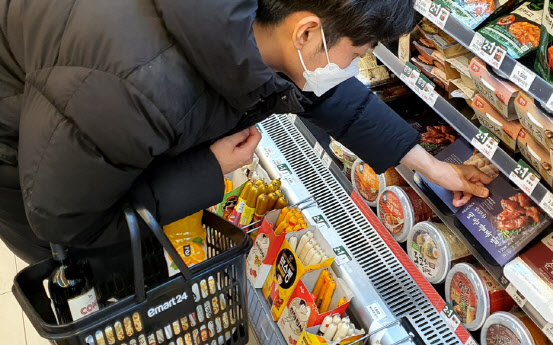|
Consumer inflation has been rising at 0% for the fourth month, but the trend of low inflation is continuing, but agricultural and livestock products have soared around 10% ahead of the holidays, and the price of processed foods and external plants has risen, so the perceived price of households is a zenith. There are concerns that the rise in overall food prices is a precursor to agflation. Agflation is a compound word of’agriculture’ and’inflation’, meaning that rising prices of agricultural products raise overall prices.
The table price without anything that didn’t rise… Green onions and onions surged by 60-70%
According to the’Consumer Price Trends for January’ of the National Statistical Office on the 2nd, the consumer price index last month was 105.79, up 0.6% from a year ago. The rate of increase in consumer prices compared to the same month last year rose to 1.0% in September last year and then reached 0.1% in October, 0.6% in November, and 0.5% in December. The overall consumer price index remains at 0%, but the price of living, consisting of items that are sensitive to price fluctuations due to the high frequency of purchase and the proportion of spending among inflation items, is on the rise. It rose 0.3% last month and turned positive in 4 months since last September.
Fresh foods such as vegetables and fruits, whose prices surged due to weather factors such as typhoons and rainy seasons last year, rose 21.5% in September and then rose by double digits for four consecutive months until December, and also rose by 9.2% in January. Green onions (76.9%) and onions (60.3%), which were sluggish due to the rainy season, surged, and apples (45.5%) and red pepper powder (34.4%) also showed a high rise. Grain prices rose 9.5% (the highest since 10.6% in July 2019) due to a decrease in rice production (-6.4% per annum), and livestock products, which have increased demand for domestic food due to the highly pathogenic avian influenza (AI) in poultry and corona, also 11.5% (2014 The highest after 12.6% in June) showed an uptrend. Pork and domestic beef rose 18.0% and 10.0%, respectively, and egg prices rose 15.2% in the aftermath of the spread of AI.
“Last year, the price of vegetables and fruits increased a lot due to typhoons and rainy seasons,” said Jun-beom Lee, head of the price policy section of the Ministry of Equipment. It is difficult to import apples and pears, which can only be harvested once a year, and there is no way other than to release as much stockpile as possible.”
|
The food and external plant districts also raise dominoes… Government “improving supply and demand conditions”
As the prices of grains such as wheat and corn are rising, prices for ramen, bread, and sweets are also rising. According to the Chicago Merchandise Exchange on the 1st (local time), the price of soybean futures per bushel (27.2 kg) was 1370 cents, up 50% from the previous year, and the price of corn recorded 549 cents, up 42%. International wheat futures prices also peaked since December 2014 due to Corona 19 and climate change. The Chicago Merchandise Exchange’s wheat futures traded at 651 cents per bushel. The number of pig breeding heads in China, which had plunged due to African swine fever (ASF), showed a strong recovery from June to July of last year. As a result, demand for feed grains increased, leading to an overall rise in grain prices.
As raw material prices have risen since last year, the price of processed foods and external plant prices are also decreasing. Ramen prices rose 0.7% last month, and since April last year (2.1%), tofu has risen 5.9%, the largest increase since November 2013 (7.1%). Accordingly, CJ CheilJedang and Ottogi raised the price of instant rice by 7-8%, and Tous les Jours also raised the price of 90 types of bread by 9% on average. Major food manufacturers such as Pulmuone, Sampyo Foods, and Dongwon F&B have raised prices, followed by eating out brands such as Lotteria and Outback.
The bigger problem is that the global grain price, which has surged since the second half of last year, has continued, which could lead to a steeper rise in food prices.
Mijin Cho, a researcher at NH Investment & Securities, said, “As the price of grains rises longer than expected, the possibility of agflation is raised.” “Especially for food and beverage companies that have exhausted their inventory due to the sharp rise in corn and wheat prices, a price hike is inevitable. I said.
Prior to the Lunar New Year, the government decided to expand the supply of key holy goods so as not to increase the burden of inflation. From the 28th of last month to the 10th of the coming month, the’expansion supply period for agricultural, livestock, and forest products’ was set, and the stockpile of holy supplies was expanded compared to normal to stabilize prices on New Year’s Day. During the period, the supply of agricultural products increased by 1.8 times and the supply of livestock products increased by 1.3 times. In particular, it plans to improve supply and demand by increasing imports and discharging stockpiles through the application of a quota tariff (0% cut until June 30) for eggs that have recently shown a high price increase.
An official from the Ministry of Equipment said, “We plan to improve supply and demand by expanding imports and discharging stockpile through the application of quota tariffs for eggs that have shown a high price increase recently.” As a result, we will focus on expanding supply.”


